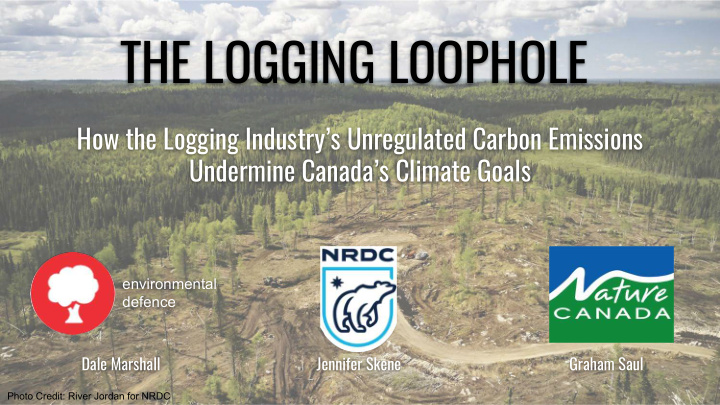



THE LOGGING LOOPHOLE How the Logging Industry’s Unregulated Carbon Emissions Undermine Canada’s Climate Goals environmental defence Dale Marshall Jennifer Skene Graham Saul Photo Credit: River Jordan for NRDC
The Boreal Forest CARBON: The Boreal Is the most carbon-dense forest on the planet. - Per Acre, it stores about twice as much carbon as the Amazon forest - In its entirety, it stores nearly twice as much carbon as all of the world’s recoverable oil reserves combined!
Boreal Boons: BIODIVERSITY: The Boreal has immense value for species, including billions of birds that nest there every year and iconic Canadian species such as Caribou. RECONCILIATION: The Boreal encompasses the traditional territory of many Indigenous Peoples and is therefore critical to reconciliation in Canada
Canada can lead on Nature Based Climate Solutions (NBCS) NBCS are: Actions which increase nature’s ability to store carbon or which avoid GHG emissions from things like cutting down trees or destroying peatland. For Example NBCS include: - Conservation - Restoration - Improved Land Management Healthy nature, especially forests, help us to manage greenhouse gas emissions.
For the first time, the Government of Canada Also note the apparent has created a meaningful commitment to IPAs and plan to support NBCS: Indigenous-led conservation. Achieve 30 million tonnes of greenhouse gas emission reductions through nature-based climate solutions by 2030; Plant 2 billion net additional trees over 10 years; Protect 30 percent of Canada’s Lands and oceans by 2030.
1.5 o C (not 2 o C) is THE threshold • Hundreds of millions more humans impacted: displacement, poverty, food/water insecurity • Many more species and even entire ecosystems at risk 6
To limit warming to 1.5 o C Global GHG emissions must decline 7.6% every year between 2020 and 2030 7
8
Need “all of the above” approach To tackle the climate crisis, need to address: • Energy-related GHGs • Ecosystem/agr carbon • Planting trees is not the only nature-based climate solution • Nature-based solutions not enough 9
10
A Logging Loophole: Is the way we log undermining our Climate Goals? Industrial logging = net GHG emitter Canada can be a global leader in sustainability and NBCS if the logging loophole is addressed. Forestry could be compatible with a sustainable future, but needs to We need to close the logging loophole undergo a transformation.
Logging in the Boreal - Clears 400,000 hectares / year, - Has negative impacts on wildlife, - Floods atmosphere with previously stored carbon, - Reduces capacity to absorb carbon for years, Turns a vast carbon vault into a climate liability.
The Continued Role of the Forestry Industry 2 main issues: No regulation to reduce the - logging industry’s carbon emissions Inaccurate accounting of - carbon emissions from logging
No Regulation of Logging Industry’s Emissions -Insufficient regulation of activities, such as road building in wetlands -No carbon pricing -Effects: - Logging industry has no incentive to adopt climate and environment - friendly management tools. - Logging industry’s significant carbon emissions remain unmitigated.
Recommendation: Regulate/Price Emissions Logging emissions need to be integrated into the Greenhouse Gas Pollution Pricing Act to promote climate-friendly forest management practices. - Protect high-carbon areas - Longer harvest rotations, - Avoiding full-tree logging, - Relying more on selective harvesting and facilitating regeneration centred on biodiversity and climate considerations. Revenue should be reinvested into Indigenous-led land management and helping communities transition into more sustainable economies.
Underestimating Carbon Emissions Canada’s carbon model downplays significant logging impacts, resulting in a significant underestimation of net emissions. The following are some significant items that prevent full transparency: - The forest does not fully recover from logging activities - The model to estimate emissions of logging activities is conservative - Accounting for carbon absorption from the entire forest obscures the increasing negative climate impacts of logging.
Logging Scars Claim of perfect regrowth and no deforestation Study in northwestern Ontario of 27 sites - Average of 14% essentially barren, even 20-30 years later - Climate impact of 41 MT CO2 Full tree logging impacts across the boreal
Conservative Estimates No accounting for mosses Both federal and provincial - Soil carbon estimates use conservative assumptions Potential “Pandora’s Box” of - emissions Resilience impacts--degraded forests are more susceptible to climate impacts (insects, wildfires)
Harvested Wood Products Embedded in Canadian policy as a climate solution Both federal and provincial - Important caveat to HWPs: they provide a climate benefit only under very strict conditions E.g. perfect regrowth - Much of what the logging industry is producing is short-lived (toilet paper, newsprint)
Close the Logging Loophole Bring industrial logging’s emissions within a carbon pricing regime, just like the fossil fuel industry - Reinvest in communities - Incentivize climate-friendly practices Fully account for industrial logging’s emissions - Better monitor and integrate forest recovery - Advance soil carbon studies, and adopt precautionary principle
Protecting Intact Forests Less than 10% of the boreal’s carbon stores are currently Intact/Primary Forests: protected. - A forest free of any significant human footprint. - These plants,animals, fungi, insects, etc. of these forests have interacted over a very long time-period, developing complex relationships. - These forests have much higher biodiversity and value for the climate. Recommendation: Integrate carbon-rich intact regions of managed forests to reach the 30% protected areas target.
Indigenous-led Land Management: - Strengthens Indigenous cultures and reconciliation efforts, - Is correlated with better protection for forest carbon, healthier ecosystems, and higher biodiversity Recommendation: - Invest in Indigenous-led land management - Fund such programs out of diverted logging subsidies, carbon pricing, etc.
Thank you! Questions?
Recommend
More recommend